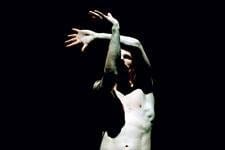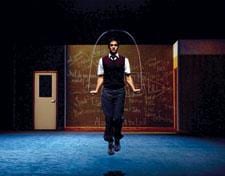
TO BE STRAIGHT WITH YOU. In Ottawa, Lloyd Newson of DV8 will be discussing the role of art in effecting social change at a free panel discussion Nov 27. Credit: Courtesy of the NAC/Matt Nettheim
Art can change the world. For Lloyd Newson, the creative force behind Britain’s famed DV8 Physical Theatre troupe, that’s one of the premises of his work.
His latest project, To Be Straight with You, which lands on the National Arts Centre dance card later this month, is steeped in the logic of art-as-activism.
The piece takes a harsh look at the real-life intersections of homosexuality, race and religion.
“There has been a lot of engagement in the show,” says Newson. “It’s about the notion of tolerance, who tolerates what. In Europe, there’s a massive issue now about this mass migration and in terms of different cultures, different religions. How we can live or coexist with one another while having different value systems? How we can respect people having different value systems but at the same time accept divergence? That’s incredibly tricky.”
Over the course of 20 years, DV8 has developed a reputation for daring physicality and difficult subject matter. Gay themes often feature prominently. Newson has taken on AIDS, public sex and a gay serial killer. But he’s also addressed straight male pub culture, disability, age, love and marriage.
“The majority of my works are not necessarily about gay issues per se,” says Newson. “What happens is every now and then my fury rises again. I think that things have changed for the better, and then all of a sudden, I start getting furious when I hear a previous head of the Muslim Council of Britain start saying that homosexuals undermine society, we’re dangerous to family life, we’re basically a health menace. So I end up making a work like To Be Straight with You.”
Do you doubt that art can effect change? Well, after participating in a recent public discussion linked to the Dublin run of To Be Straight with You, Inayat Bunglawala, an official with the Muslim Council of Britain, published an article in the Guardian calling for greater tolerance and understanding of the situation of gay Muslims. Newson sees it as “a beginning.”
DV8 avoids the typical trappings of contemporary dance, particularly the tendency toward abstraction. Instead, Newson taps into a raw realism that flows from extensive preparatory research. For To Be Straight with You, they did 85 in-depth one-on-one interviews plus 200-odd random streeters with people representing a full range of opinions on and experiences with race, religion and homosexuality. Newson ultimately drew on diverse material from 25 of the interviews to create a series of monologues in motion for his actor-dancers.
To Be Straight with You also incorporates audio-visual effects such as music, animation and film. For example, it includes what Newson calls “reggae murder music lyrics” from homophobic songs.
“One of the black lesbians that we interviewed said if you just change the word gay in these songs, the word batty man — patois for a gay man — if you just change that word for black or for woman or for Muslim, there would be an uproar,” he says. “Because there’s a historic colonial guilt thing operating, we allow it to get by.”
Although artistic expression is DV8’s raison d’être, there’s also an educational impetus. The DV8 website has a downloadable educational work pack for To Be Straight with You. The company has also made its acclaimed films available to high schools and universities. In Toronto, they plan to visit students at the Triangle Program, an alternative stream for queer students who have had difficulty in regular public schools. In Ottawa, the National Arts Centre is hosting a free public panel discussion on the role of art as a tool for social change, featuring Newson among the panelists.
These days, in places like Canada and the United Kingdom, with comparatively progressive laws, complacency is common in the queer community. Newson, thankfully, is anything but complacent, and his political engagement fuels his artistic drive.
He laments that of all the people he interviewed, only very few who are gay and members of specific religious or visible minority groups would agree to being identified by name for fear of the consequences within their communities.
“We can’t underestimate even within our supposedly liberal democratic societies how hard it still is for two people, regardless of faith or colour, for two people of the same sex to walk hand-in-hand down the road without being intimidated. What other group does not have that privilege?”

 Why you can trust Xtra
Why you can trust Xtra


